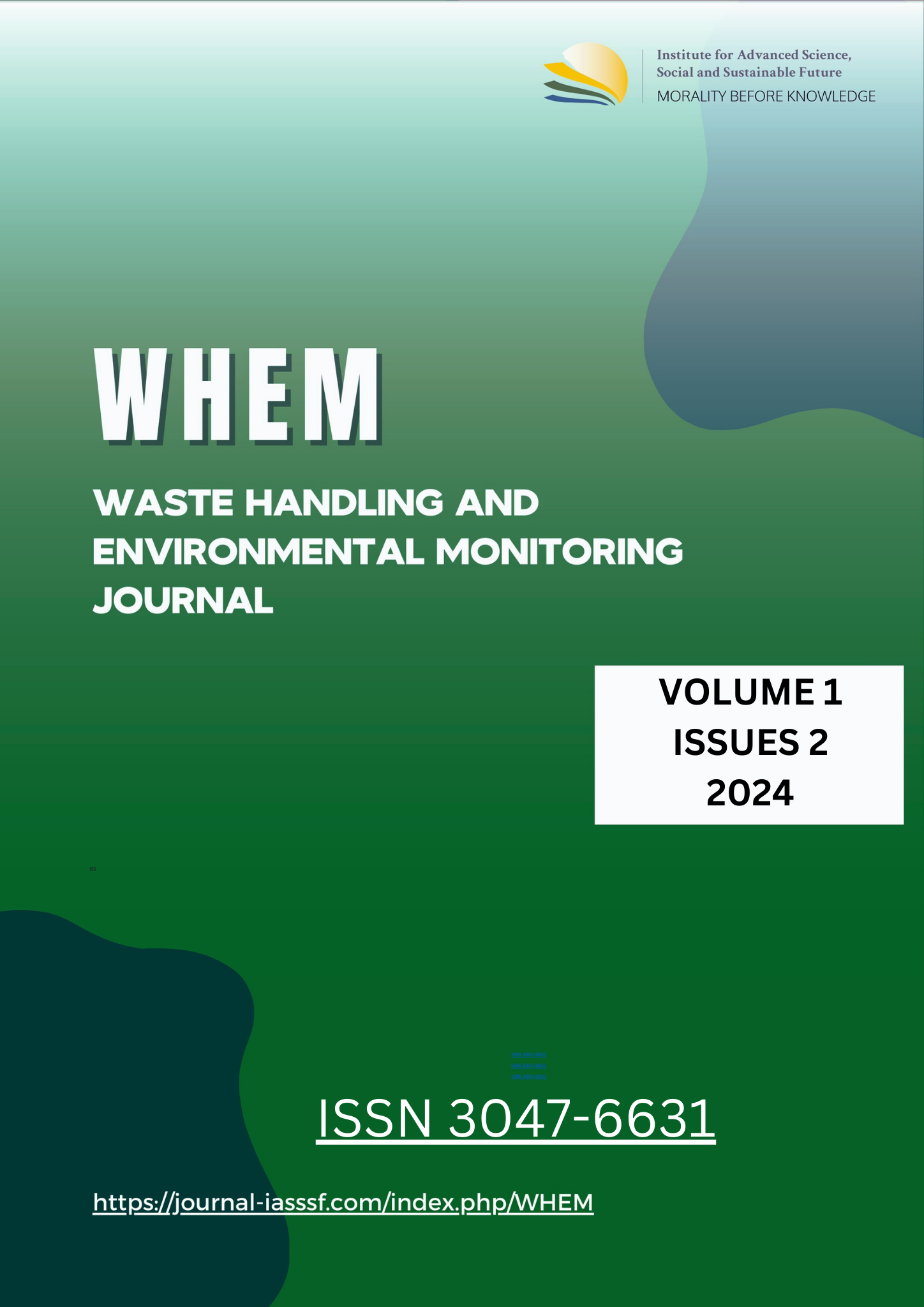Karakteristik limbah pertanian dan dampaknya: Mengapa pengelolaan ramah lingkungan penting?
DOI:
https://doi.org/10.61511/whem.v1i2.2024.1204Keywords:
circular economy, organic waste, pollution, waste management, agricultural systemAbstract
Background: Agricultural waste is a significant by-product of the agrarian sector, with the potential for substantial environmental and economic impacts. This study aims to examine the characteristics of organic agricultural waste and analyze its effects on the environment, both in terms of threats and its potential utilization. Method: This study employs a systematic literature review method. The literature search focuses on articles discussing agricultural waste, its characteristics, and its environmental impacts. Findings: The results show that agricultural waste has diverse characteristics based on fiber composition, physical form, and protein content. The main threats from agricultural waste include water pollution due to nutrient runoff and greenhouse gas emissions, especially methane. However, this waste also holds significant potential as a source of organic mulch, animal feed, and raw material for bioenergy. Utilizing agricultural waste as mulch can improve soil quality and crop yields, while its use as animal feed supports the integration of agricultural and livestock systems. In the context of energy, converting waste into biogas and biofuel offers an effective solution. Conclusion: This study emphasizes the importance of integrated and sustainable agricultural waste management to minimize negative impacts and optimize its economic potential. Novelty/Originality of this article: By providing a comprehensive analysis of the characteristics and impacts of agricultural waste, this study offers insights into the importance of a holistic approach to agricultural waste management to support sustainable agriculture.
References
Adinata, K. I. (2020, December). Daya tampung limbah tanaman pertanian sebagai sumber pakan ternak sapi potong di Kabupaten Kudus. In Seminar Nasional Kahuripan (pp. 154-158). https://conference.kahuripan.ac.id/index.php/SNapan/article/view/41
Agustono, B., Lamid, M., Ma’ruf, A., & Purnama, M. T. E. (2017). Identifikasi limbah pertanian dan perkebunan sebagai bahan pakan inkonvensional di Banyuwangi. Jurnal Medik Veteriner, 1(1), 12-22. https://doi.org/10.20473/jmv.vol1.iss1.2017.12-22
Alhazmi, H., & Loy, A. C. M. (2021). A review on environmental assessment of conversion of agriculture waste to bio-energy via different thermochemical routes: Current and future trends. Bioresource Technology Reports, 14, 100682. https://doi.org/10.1016/j.biteb.2021.100682
Alibardi, L., & Cossu, R. (2015). Composition variability of the organic fraction of municipal solid waste and effects on hydrogen and methane production potentials. Waste management, 36, 147-155. https://doi.org/10.1016/j.wasman.2014.11.019
Aslam, M. U., Chattha, M. U., Khan, I., Maqbool, R., Chattha, M. B., Hussan, F., ... & Hassan, M. U. (2021). Effect of different organic mulches and nitrogen sources on the productivity of wheat crop grown in semi-arid area. https://doi.org/10.17582/journal.pjar/2021/34.3.648.655
Atinkut, H. B., Yan, T., Zhang, F., Qin, S., Gai, H., & Liu, Q. (2020). Cognition of agriculture waste and payments for a circular agriculture model in Central China. Scientific Reports, 10(1), 10826. https://doi.org/10.1038/s41598-020-67358-y
Budiastuti, M. T. S., Manurung, I. R., Setyaningrum, D., Nurmalasari, A. I., & Arista, N. I. D. (2021, November). The role of organic fertilizer from natural dye waste and mycorrhizal inoculation on the growth of Indigofera tinctoria L. In IOP Conference Series: Earth and Environmental Science (Vol. 905, No. 1, p. 012011). IOP Publishing. https://doi.org/10.1088/1755-1315/905/1/012011
Campuzano, R., & González-Martínez, S. (2016). Characteristics of the organic fraction of municipal solid waste and methane production: A review. Waste Management, 54, 3-12. https://doi.org/10.1016/j.wasman.2016.05.016
Cross, S., Welfle, A. J., Thornley, P., Syri, S., & Mikaelsson, M. (2021). Bioenergy development in the UK & Nordic countries: A comparison of effectiveness of support policies for sustainable development of the bioenergy sector. Biomass and Bioenergy, 144, 105887. https://doi.org/10.1016/j.biombioe.2020.105887
Food and Agriculture Organization [FAO]. (2017). IWMI Water Pollution from Agriculture: A Global Review Executive Summary. Rome: Food and Agriculture Organization of the United Nations and the International Water Management Institute.
Irianto, I. K. (2015). Pengelolan Limbah Pertanian.
Li, Z., Wen, X., Hu, C., Li, X., Li, S., Zhang, X., & Hu, B. (2020). Regional simulation of nitrate leaching potential from winter wheat-summer maize rotation croplands on the North China Plain using the NLEAP-GIS model. Agriculture, Ecosystems & Environment, 294, 106861. https://doi.org/10.1016/j.agee.2020.106861
Massarelli, C., Losacco, D., Tumolo, M., Campanale, C., & Uricchio, V. F. (2021). Protection of water resources from agriculture pollution: An integrated methodological approach for the nitrates Directive 91–676-EEC implementation. International Journal of Environmental Research and Public Health, 18(24), 13323. https://doi.org/10.3390/ijerph182413323
Nielfa, A., Cano, R., & Fdz-Polanco, M. (2015). Theoretical methane production generated by the co-digestion of organic fraction municipal solid waste and biological sludge. Biotechnology Reports, 5, 14-21. https://doi.org/10.1016/j.btre.2014.10.005
Nisbet, E. G., Allen, G., Fisher, R. E., France, J. L., Lee, J. D., ... & E. Wilde, S. (2022). Isotopic signatures of methane emissions from tropical fires, agriculture and wetlands: The MOYA and ZWAMPS flights. Philosophical Transactions of the Royal Society A: Mathematical, Physical and Engineering Sciences, 380(2215). https://doi.org/10.1098/rsta.2021.0112
Panjaitan, E., Sidauruk, L., Indradewa, D., Martono, E., & Sartohadi, J. (2020). Impact of agriculture on water pollution in deli serdang regency, North Sumatra Province, Indonesia. Organic Agriculture, 10(4), 419-427. https://doi.org/10.1007/s13165-020-00282-7
Ridwan, R., Prasetyo, S. D., Kusuma, A. C., Rahman, R. A., & Suyitno, S. (2019, April). Recent progress of biogas produced from the waste of natural indigo dyes for electricity generation. In AIP Conference Proceedings (Vol. 2097, No. 1). AIP Publishing. https://doi.org/10.1063/1.5098200
Thitanuwat, B., & Wongsoonthornchai, M. (2021). Estimation of Nitrogen Loading to Surface Water from Agriculture Based Area and Its Application for Water Pollution Mitigation. Environment & Natural Resources Journal, 19(3). https://doi.org/10.32526/ennrj/19/2020239
Zangoueinejad, R., & Alebrahim, M. T. (2021). Use of conventional and innovative organic materials as alternatives to black plastic mulch to suppress weeds in tomato production. Biological Agriculture & Horticulture, 37(4), 267-284. https://doi.org/10.1080/01448765.2021.1947377
Downloads
Published
How to Cite
Issue
Section
Citation Check
License
Copyright (c) 2024 Waste Handling and Environmental Monitoring

This work is licensed under a Creative Commons Attribution 4.0 International License.

















